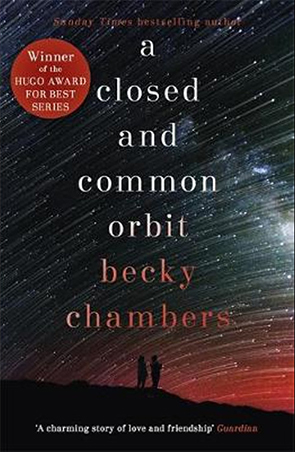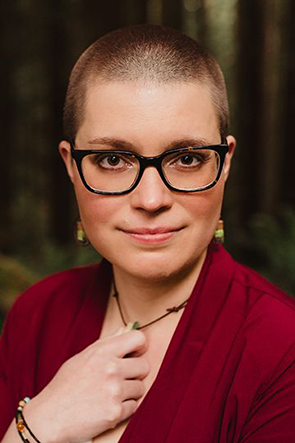A Closed and Common Orbit is the second book of the Wayfarers Series. Its opening overlaps with the end of the first book, The Long Way to a Small Angry Planet. To understand what happens, there needs to be a few spoilers for the first book, so I 'll get them out of the way early. One of the two main characters in this book is Lovelace, the Wayfarer’s AI. After her initial installation on the Wayfarer, Lovelace had developed into the personality Lovey. When the Wayfarer is attacked by a Toremi ship near the end of the book, Lovey suffered a catastrophic cascade failure. The Techs did a hard system reset in a final effort to save her. This restored Lovelace but the Lovey persona was lost forever. Not only did the crew lose a friend in Lovey, Lovey and Jenks were in a romantic relationship. Jenks is devastated by her ‘death’. The continued presence of Lovelace on the Wayfarer would be difficult for most of the crew and impossible for Jenks.
Lovey and Jenks had decided to transfer Lovey into a 'body kit', an illegal practice in the GC where AIs are not regarded as people and do not have any legal rights. Jenks had obtained the body kit, but there was an incident on the ship where the police in one system they passed through discovered that a crew member was actually a clone and everyone had to deal with the consequences of this discovery. There are inter-species relationships in the book, including one where one of the couples needs to hide her relationship from others of her species, because sex outside the species is regarded as taboo. But this relationship would be a minor scandal compared to what would happen if an AI in a body kit was discovered onboard the Wayfarer. So, Lovey and Jenks decided to think a bit more before they took such a significant step. Lovey was still in the Wayfarer core when they attacked. So Pepper, a minor character, suggests to Lovelace that she transfer to the body kit and move to Port Coriol with her.
This second book opens with Lovelace, now known as Sidra, and Pepper travelling to Port Coriol. The story is then told on two timelines - one in the present day where Sidra learns how to be a human, and the other starting around twenty years earlier to give us Pepper’s backstory. The stories eventually connect. As much as I loved Small Angry Planet, this is a more engrossing story, and it strangely feels like it has more substance, even though it probably has even less of a plot. Both Sidra’s and Pepper's stories are about survival and learning who you are in a new environment.
Chambers expands the world she created in Small Angry Planet, especially through Pepper’s story. Pepper, originally called Jane 23, was born in a human colony where scientists took gene-tweaking technology to extremes, creating a colony where everyone is bred for a specific role in society, similar to the engineered reproduction system of Brave New World. Jane 23 was bred as a slave, with her life meant to be contained within a single factory, repairing old technology. There is an accident in the factory one day, and Jane 23 catches a glimpse of the sky outside the factory. Intrigued, she sneaks outside that night to see what is out there. She is discovered, has to flee to avoid being killed, and finds refuge in a spaceship that has been long abandoned in the huge technology junkpile that surrounds the factory. The AI on the ship, who has been alone on the ship since her crew were captured and probably killed by the people who control the planet, helps Jane 23 learn how to survive, and together they repair the ship and escape to GC controlled space. This takes them around 9 years. Pepper survives in that harsh, isolated world only with the help and friendship of Owl, the AI.
Sidra’s story is less dramatic, but equally compelling, as she struggles to adapt to her new life without revealing her illegality to anyone. Although it was her choice to leave the Wayfarer and enter the body kit, she is never comfortable and regrets what she has lost. She continues to refer to her body as ‘the kit’ (as in "Sidra moved the kit through the room"), in a way that demonstrates that she feels no connection with her physical interface with the world. She tells a tattoo artist “this kit isn’t me” in an attempt to explain to him why she wants a tattoo: she has heard the tattooist talk about the disconnect that many people feel between their body and their mind, and how a tattoo can re-enforce a connection between the two.
This never changes over the book. Sidra is never able to accept the kit as her body, it is always something that is separate to her identity. She feels restricted, even downgraded, and misses her previous installation. The life she has to live on Port Coriol goes against her programmed primary purpose. She was designed to be installed on a spaceship, to have total awareness of her surroundings, and is now reduced to seeing only what the 'limited' vision of the kit allows her to see. She frets that the kit will run out of memory and that she will be forced to dump files. She develops a form of agoraphobia, never really comfortable when she is outside, when there is too much around her that she can’t monitor. Other parts of her programming also hinder her life, such as not being able to tell a lie and having to respond to direct requests.
It is surprising how human Sidra's story is, like watching a child gradually understand their place in the world and work out how best to interact with that world, while having an existential crisis.
What is the appeal of these books? It's more than just likeable characters that are upbeat and feelgood without being cloying. The friendship between the characters feels real. You believe these people care for each other, but also trust each other enough to let them make their choices on how to live. There’s an exploration of different cultures living together and creating a stable society, and the value of inclusiveness is constantly in the background but never overtly shoved in your face. There are no epic battles where the survival of mankind is at stake, just the stories of regular people learning how to survive in their ordinary world. The storytelling and world creation is beautiful, the characters are complex, and overall, this is just a very readable story.
Highly recommended.

 RSS Feed
RSS Feed Facebook
Facebook Instagram
Instagram YouTube
YouTube Subscribe to our Newsletter
Subscribe to our Newsletter




No one has commented yet. Be the first!